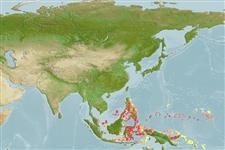Classification / Names
Common names | Synonyms | Catalog of Fishes (gen., sp.) | ITIS | CoL | WoRMS | Cloffa
Actinopterygii (ray-finned fishes) >
Perciformes (Perch-likes) >
Labridae (Wrasses) > Corinae
Etymology: Halichoeres: Greek, als, alis = salt + Greek, choiros = pig (Ref. 45335); hilomeni: Named for Dr. Vincent V. Hilomen of the University of the Philippines Los Baños in recognition of his efforts in obtaining collection and export permits and arranging the shipment of the type specimens to the authors.. More on author: Randall.
Environment / Climate / Range
Ecology
Marine; reef-associated; depth range 1 - 3 m (Ref. 85096). Tropical, preferred ?
Western Central Pacific: Philippines and Malaysia.
Size / Weight / Age
Maturity: Lm ? range ? - ? cm
Max length : 9.6 cm SL male/unsexed; (Ref. 85096)
Short description
Morphology | Morphometrics
Dorsal
spines
(total): 9;
Dorsal
soft rays
(total): 12;
Anal
spines: 3;
Anal
soft rays: 12;
Vertebrae: 25. This species is characterized by the following: D IX,12; A III,12; pectoral rays 14; lateral-line scales 27; head naked but nape fully scaled; most scales of straight anterior part of lateral with a middle surface tubule forming 3 short branches ending in a pore, with the middle branch usually longest; suborbital pores 10-13; gill rakers 18-20; body depth 3.15-3.6 in SL; head length (HL) 2.9-3.0 in SL; snout length 2.85-3.25 in HL; dorsal spines progressively longer posteriorly, last 3 subequal, 2.85-3.4 in HL; caudal fin moderately rounded, 1.35-1.5 in HL; upper half of body dark brown, males with 5 narrow pale bars extending from base of dorsal fin; lower half of body pale brown, the centres of scales darker; a dark brown band from upper lip to lower half of orbit, extending posterior to eye, half as broad, to base of opercular flap; 3 narrow dark bars extending dorsally from postorbital band, the first black and vertical, just behind eye, the posterior 2 bands irregular; a boomerang-shaped dark brown band extending posteriorly from behind corner of mouth across cheek; fins are translucent pale yellowish, dorsal with a broad black band across middle of first 2 membranes; rest of fin with longitudinal rows of faint, dark-edged, pale spots (3 per membrane); anal fin with a row of faint, dark-edged, pale spots along base; caudal fin with faint transverse bands; paired fins pale, the pectorals with a triangular black spot dorsally on base, narrowing to a line across remainder of base; peritoneum dark brown (Ref. 85096).
Occurs in a sheltered habitat of mixed coral, algae, sand and gravel (Ref. 85096). Found in small groups or solitary (Ref. 90102).
Life cycle and mating behavior
Maturity | Reproduction | Spawning | Eggs | Fecundity | Larvae
Distinct pairing during breeding (Ref. 205).
Randall, J.E. and G.R. Allen, 2010. Two new labrid fishes of the genus Halichoeres from the East Indies. The Raffles Bull. Zool. 58(2):281-289. (Ref. 85096)
IUCN Red List Status (Ref. 115185)
CITES (Ref. 94142)
Not Evaluated
Threat to humans
Harmless
Human uses
More information
Age/SizeGrowthLength-weightLength-lengthLength-frequenciesMorphometricsMorphologyLarvaeLarval dynamicsRecruitmentAbundance
ReferencesAquacultureAquaculture profileStrainsGeneticsAllele frequenciesHeritabilityDiseasesProcessingMass conversion
Tools
Special reports
Download XML
Internet sources
